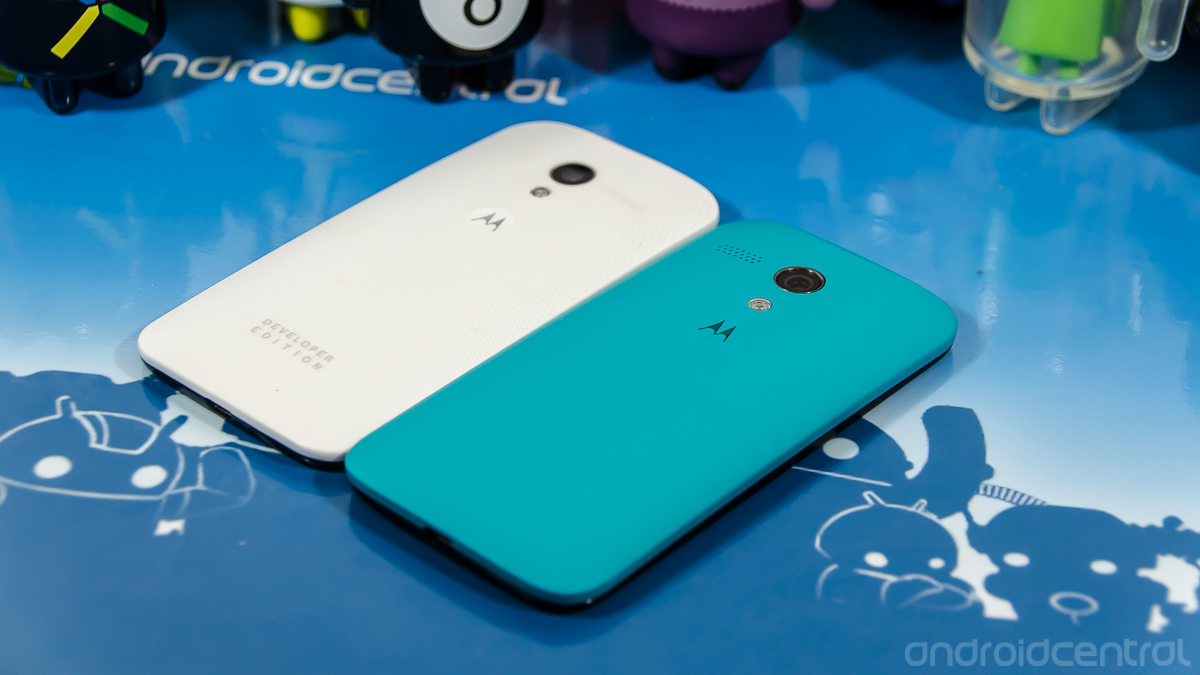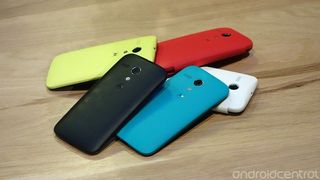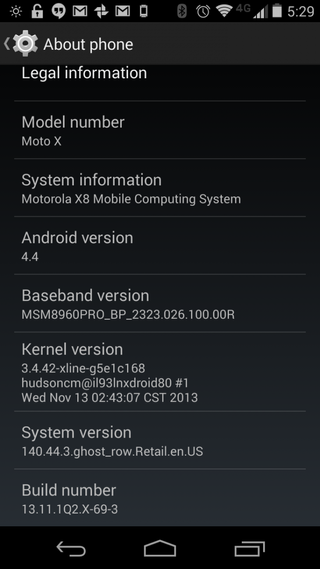Moto G versus Moto X

A look at Motorola's low end, and how it matches up against the high end
It's time to compare apples to oranges. One of these things is not like the other. Insert your own dry, not very witty and overused nugget of colloquial wisdom here. But we're going to compare the Moto X against the new Moto G.
The Moto X — even without all the cores and other numbers that send the spec-conscious all in a tizzy — is Motorola's high-end device for the high-end market. It's well-built, fast, loved by just about everyone who has used it — and is our pick as the best smartphone you can buy at the moment. It's everything that the old Motorola wasn't, and a fresh, new offering from the company that invented the cell phone.
The Moto G is the other end of the Android spectrum. It's inexpensive, accessible all over the world and targeted at blossoming smartphone adopters in countries without the high market penetration rates we see in the west. The good news is, unlike the usual budget handsets with fairly shoddy craftsmanship and plain bad performance, the Moto G is a damn good phone. It's solid, dependable and speedy — all for under $200.
Follow along, and we'll see where these two are similar and where they aren't.
Externals
Other than a few differences, these two look and feel identical in your hands. Both are built from well-constructed, soft-touch materials, have superb fit and finish, and are ergonomically designed to fit naturally in your hand. The rear of the phone is slightly swelled, and the back has enough texture to not feel slippery even when your hands aren't fully dry. Cut-outs for the camera, the LED flash and speaker grill are precision cut, and each features a small dimple in the center where the Motorola logo is. We're not sure of any purpose this may have, but your index finger will find it and you will rub it while you're using either the X or the G.


Around front, there are a few small differences. For starters, the camera opening is on the right on the Moto X and on the left on the Moto G. The hardware itself is different as well, but we'll get into that in the next section. The biggest difference is where the sides meet the glass. On the Moto X the glass is flush and smooth where it meets the plastic side, while on the Moto G the plastic side wraps around the edge of the glass ever-so-slightly. We've a feeling that this design difference is a by-product of the easily removable back on the Moto G.
Get the top Black Friday deals right in your inbox: Sign up now!
Receive the hottest deals and product recommendations alongside the biggest tech news from the Android Central team straight to your inbox!

The customization department is the biggest difference. As mentioned above, the back panel of the Moto G snaps on and off, allowing users to change the back cover on a whim. There are a handful of different styles and colors, and they are cheap enough and easy enough to change that you can grab several.
The Moto X on the other hand, is customized during the buying process at Moto Maker. You can choose from different color shells and faces, as well as get a colored anodized coating on the buttons and camera ring.
Neither phone gains any function from these, unless looking good while using it is a function. What's important to us is that the Moto G's back cover can be removed, but the phone feels every bit as solid as the Moto X. The secret? The Moto X also has a removable back cover. A bit of care and a guitar pick will pop it right off, and it snaps right back into place.
In a nutshell, they are both very nicely build phones.
Internals

You can look at the full specs for the Moto X here; the Moto G here. If you're a spec guy, go on and do that then come back. We'll have a look at the major differences right here.
The Moto X has an 4.7-inch AMOLED screen at 720p (316 ppi). The Moto G has a 4.5-inch LCD at 720p (329 ppi). The screen on the Moto G is a little smaller, and it's a little better. "Better" may be a result of the LCD versus AMOLED situation, where everything that's not black looks brighter and clearer, or the screen may just be really good. The Moto G gets a tip of the hat for having such a good screen on a budget phone, but the Moto X has an AMOLED screen for a software feature which we'll look at in a bit.
The Moto G is a 3G-only phone. The Moto X has been engineered to work with the US carriers LTE networks, but the G is strictly penta-band HSPA+ 14.4 tri- or quad-band HSPA+ 21 (depending on model). Repeat: No LTE on the Moto G.
Internal storage mirrors the price point. The Moto G comes in an 8GB or a 16GB version, while the Moto X comes in 16GB or 32GB versions. It would have been nice to see 32GB or even 64GB of storage on the G, since it is geared towards emerging markets where there isn't a consistent network connection. We also know that would make for a phone more expensive that what we have. You can't have both.
Other than these obvious differences, we need to talk performance. The Moto G is no Nexus 5 (or Moto X for that matter) when it comes to being speedy, but it's perfectly fine and rivals the mid-year 2013 flagships like the HTC One or Galaxy S4 for responsiveness, fluidity and smile-factor when using it. If pressed, I would say the Moto G performs about as well as the Nexus 4, until you put a big load on the system, like downloading a list of apps from Google Play. The X8 computing system inside the Moto X is clearly superior, but most of the time you'll never notice it.
The cameras

Want to find a way to make the Moto X camera look good? Compare it to the Moto G.
The software is the same since the update for the Moto X (and it's pretty good, but bare-bones), but the hardware differences are plain to see. The Moto G and its 5MP camera don't quite cut the mustard, while the Moto X and its 10MP camera just barely does.
Don't buy either of these for the camera. Just don't. Here's a one shot (when I test, there is only one chance!) test of each while clamped in a tripod mount. Focal and exposure for each was set right on the shutter button of the camera. Besides the obvious grain, color balance and focus issues, notice the much wider field of view on the Moto X.

Moto X camera sample

Moto G camera sample
While neither is great, the Moto X gives a better result out of the camera with no editing — though it's a hair too over-exposed in the background.
The Software


Motorola's new software mantra is to follow parent company Google's lead, make "useful" additions that don't compete with already-supplied core services, and deliver phones with software that doesn't make the phone run poorly. Woodside and Soni said as much in Brazil when the announced the Moto G. They've succeeded.
Think "stock" Android, with no bells and whistles, then add in a few well-made bells and whistles, and that's what Motorola now delivers. Both the Moto G and the Moto X have Moto Assist, Trusted Bluetooth devices, Motorola Migration utility, and a custom camera app. They work as designed, and the experience is the same across both devices.
There are a few differences, though.
For starters, the Moto X was the first phone to KitKat, so it's running Android 4.4. The Moto G is expected to be updated in January, and we have no reason to doubt that Motorola can do just that — they did tame the beast that is Verizon, remember? But to be honest, on the user-facing side you'll see little difference. Blasphemy, but true.
The tangible difference is the addition of two features on the X that the G lacks — Touchless Control and Active Display. With the Droid Mini as the outlier, both these features are hardware dependent. Touchless Control requires a specific microprocessor dedicated to its operation (this is why S Voice kills your battery and Touchless Control doesn't), and Active Display works best with an AMOLED display so that only a portion of the screen is active. It's also very likely that Motorola wants to keep a few features for its high-end device. We can't say we blame them.
The bottom line

We're not going to pretend that these phones should be compared against each other on any real level. We had to look because we want to see the direction the new Motorola is going at both ends of their product line, and because on some level the Moto X and the Moto G very much resemble each other.
While the Moto G won't ever win this sort of head-to-head comparison, it does come out pretty favorably. In fact, we would be comfortable recommending it to any smartphone user providing the limitations of no LTE network and no 32GB (or higher) option don't clash with their needs. It really is that good.
And with an off-contract price of $199 (just go ahead and spend the extra $20 for double the storage), it's bound to find its way into more than a few gift boxes this year.
That's the polite, certified AC take on things. Here's the Jerry take:
I don't play games on a phone, I have a Nexus 7 for that. If the Moto G had Active Notifications and Touchless Control, it would be all the phone I ever needed. If you're buying this for a new smartphone user, as a backup device, or a replacement for another cheap, pre-pad phone, you've made a damn good choice.

Jerry is an amateur woodworker and struggling shade tree mechanic. There's nothing he can't take apart, but many things he can't reassemble. You'll find him writing and speaking his loud opinion on Android Central and occasionally on Threads.

Am I dreaming?! Samsung's early Black Friday sale launches up to $650 OFF the Galaxy S24 Plus with a trade-in, or up to $275 without

New to Garmin? The $100-off Vivoactive 5 is the perfect starting point

Forget the Fire Tablet, get this 11-inch Samsung tablet for the same price during Best Buy's Black Friday sale